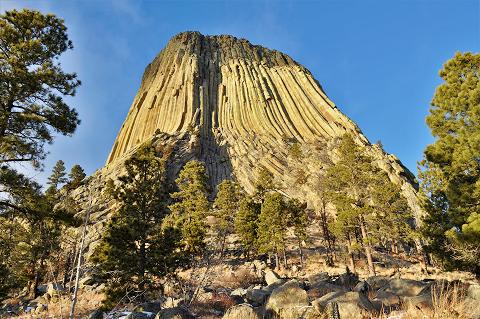 |
Canku Ota
|
 |
|
(Many Paths)
|
||
|
An Online Newsletter
Celebrating Native America
|
||
|
October 2018 - Volume
16 Number 10
|
||
|
|
||
|
Preserving Ancestral
Lands Of The Black Hills
|
||
|
by Latoya Lonelodge
- Staff Reporter Cheyenne & Arapaho Tribal Tribune
|
||
Rising through the Great Plains of North America are the historical and sacred region of the Black Hills that extend from South Dakota into Wyoming. Along with the scenic routes and beautiful landscapes that lavish the Black Hills are also historical roots planted deep within Native American culture that are not known to many today. Known for its sacredness in native culture, Black Hills was the region in which various Tribes paid homage to, including the Lakota, Omaha, Cheyenne, Arapaho, Kiowa and Kiowa-Apache Tribes. The connection between Tribes and the sacredness of Black Hills throughout history remains a topic of interest as the National Park Service (NPS) strives to seek input from Native communities. Christina Gish Hill, professor in American Indian Studies at Iowa State University, traveled to the Cheyenne and Arapaho community with the goal of gaining perspectives from the Tribes to present to the NPS for resource management. A particular topic of interest among the Tribes' perspective the NPS is seeking surrounds the controversial monument of Mt. Rushmore, a 60 foothigh granite sculpture of U.S. presidents George Washington, Thomas Jefferson, Theodore Roosevelt and Abraham Lincoln. "I wanted to participate in this project because I got the sense from the park service that they care about Native peoples' perspectives on that monument and so they're reaching out to communities and Native Nations that are connected to the Black Hills because they want to hear what peoples' perspectives are about the fact the monument is in such an important sacred place for these communities. I'm really hopeful about what's going to come out of it because a couple of things I wanted to focus on are why, generally speaking, the Black Hills are so important and why Mt. Rushmore is a problem in the Black Hills," Hill said.
The sculpture was first built as a representation of the American patriotism of favored individuals in history. However, many see the monument as a symbol and reminder of the country's betrayal against Native Americans. Hill believes participating in the project gives people the opportunity to talk to NPS about what changes they would like to see. "If people have any kind of recommendations for things that the Park Service could do, to make this more accessible, to represent the Cheyenne and Arapaho perspective in that place, those are the kinds of things I'm interested in and it's an opportunity to get that information and give those ideas to the Park Service, I'm excited about that," Hill said. Throughout history, Black Hills has proven to be a profound place of sacred meaning to Native Americans. "There's a really profound religious meaning connected to Black Hills and different places within the hills that are connected to religious knowledge or experience, then of course there's historical meaning too. Cheyenne and Arapaho people have been in that area for generations upon generations," Hill said. As the region of Black Hills has become most popular for its tourist attraction, the history surrounding the region remains unknown to the public. " The entire region of Black Hills itself was a central point for our home place and it became our home from where we migrated … that's where we found our ways as far as being what we have now and the way we act. Not only where our sacred items came from but our lifestyle too. It's our home, that's where we can always find medicines we need, food, we have a lot of roots out there and grasses we can still use, it's natural things we can use in our ceremonies and even in our daily lives that are still there," Max Bear, Tribal Historic Preservation director said. The project surrounding Black Hills and Mt. Rushmore is an endeavor from NPS to gain perspective on behalf of Native Americans to make changes, if possible. "And it's a start. They're just starting out on this project, they haven't moved to the official consultation process yet. Right now they just want general thoughts and ideas and they haven't really done something like this in the past, so this is their starting place," Hill said. According to the participation form provided from the University of Massachusetts Amherst, participation in the research may contribute to a clearer understanding by the NPS and Department of Conservation and Recreation officials of the active maintenance of the Black Hills as a cultural landscape historically to the present and the contemporary legacy of this for C-A people. It may also help the National Park Service to enhance public understanding of the Black Hills and Mount Rushmore as a native landscape and identify areas of shared interest and scholarship. For input, questions or concerns contact Christina Gish Hill by calling 515-294-0101 or via email, cghill@iastate.edu. |
||||
|
|
|
|
||
|
|
||
| Canku Ota is a free Newsletter celebrating Native America, its traditions and accomplishments . We do not provide subscriber or visitor names to anyone. Some articles presented in Canku Ota may contain copyright material. We have received appropriate permissions for republishing any articles. Material appearing here is distributed without profit or monetary gain to those who have expressed an interest. This is in accordance with Title 17 U.S.C. Section 107. | ||
|
Canku Ota is a copyright ©
2000 - 2018 of Vicki Williams Barry and Paul Barry.
|
||
 |
 |
|
|
The "Canku
Ota - A Newsletter Celebrating Native America" web site and
its design is the
|
||
|
Copyright ©
1999 - 2018 of Paul C. Barry.
|
||
|
All Rights Reserved.
|
||

